Abstract
Metastatic infection after hematogenous dissemination of Candida species is presumably dependent on the fungus traversing the vascular endothelium. An in vitro model of the earliest events of metastatic Candida infection was developed with whole vascular strips. Freshly obtained porcine blood vessels were secured in a perforated Lucite template that allowed the application of yeasts directly to the endothelial surface. Multiple wells allowed experimental and control observations on the same vascular segments. Adherence to endothelium was greatest with Candida albicans and Candida tropicalis, less with Candida Krusei, and least with Candida parapsilosis, Candida pseudotropicalis, and Torulopsis glabrata. This hierarchy of adherence parallels that in other in vitro systems employing mucosal epithelial cells or fibrin-platelet matrixes and reflects the known virulence of the respective species and their potential for hematogenous dissemination. C. albicans and C. tropicalis yeasts that adhered were capable of directly traversing the endothelial surface before the production of germ tubes. Heat or Formalin-killed yeasts and viridans group streptococci, although adherent, were incapable of vascular penetration, a process presumably attributable to enzymatic digestion of host tissue. Loss of integrity of penetrated endothelial tissue was verified by loss of dye exclusion, lactic dehydrogenase release, and ultramicroscopic changes. These two steps, adherence and penetration, provide direct insight into the earliest events in hematogenous Candida species dissemination and suggest that C. albicans and C. tropicalis yeasts are capable of initiating tissue invasion before germ tubes have had the opportunity to form and participate in the invasive process.
Full text
PDF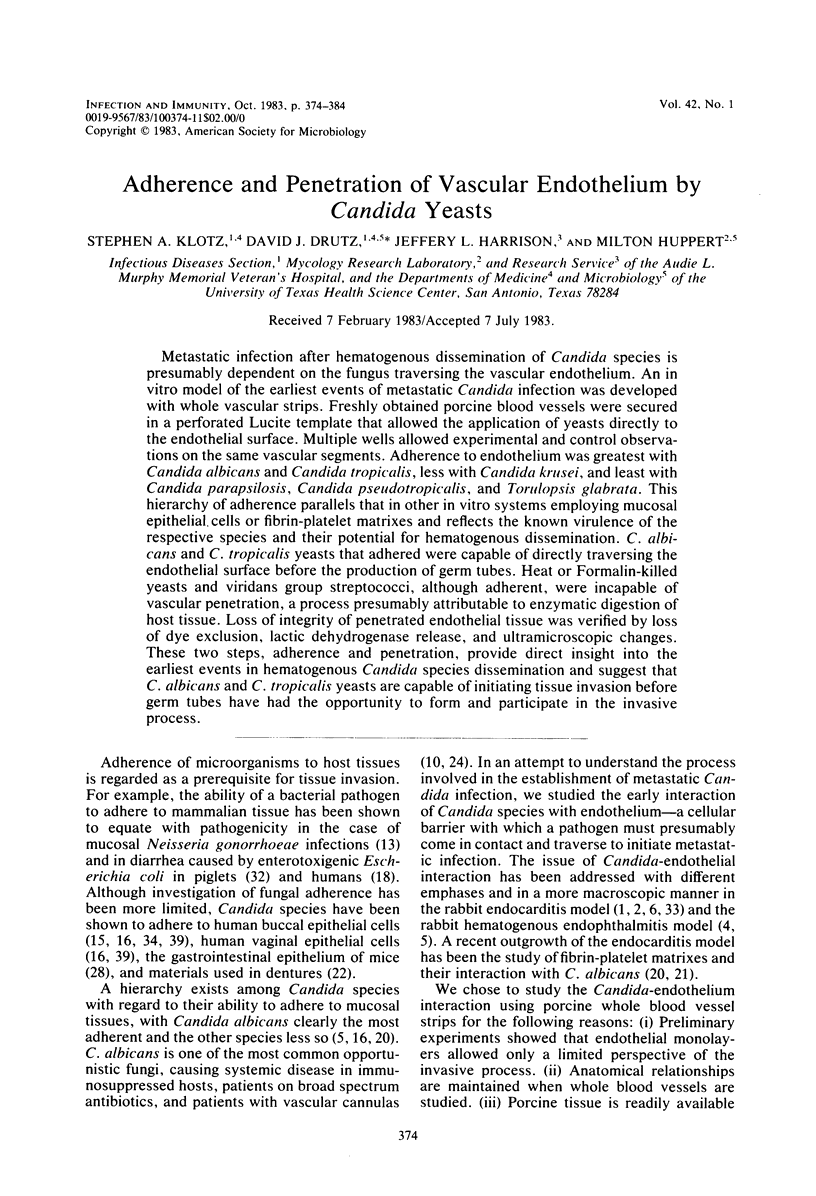

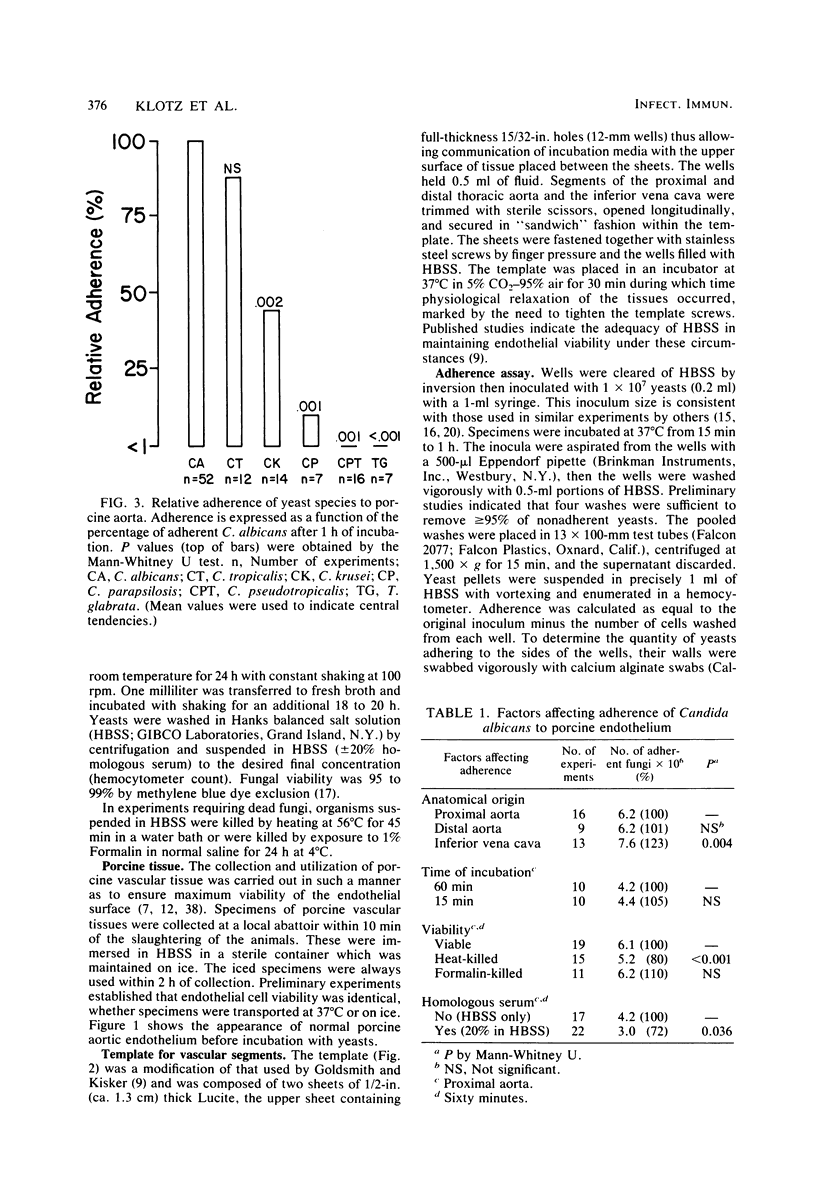

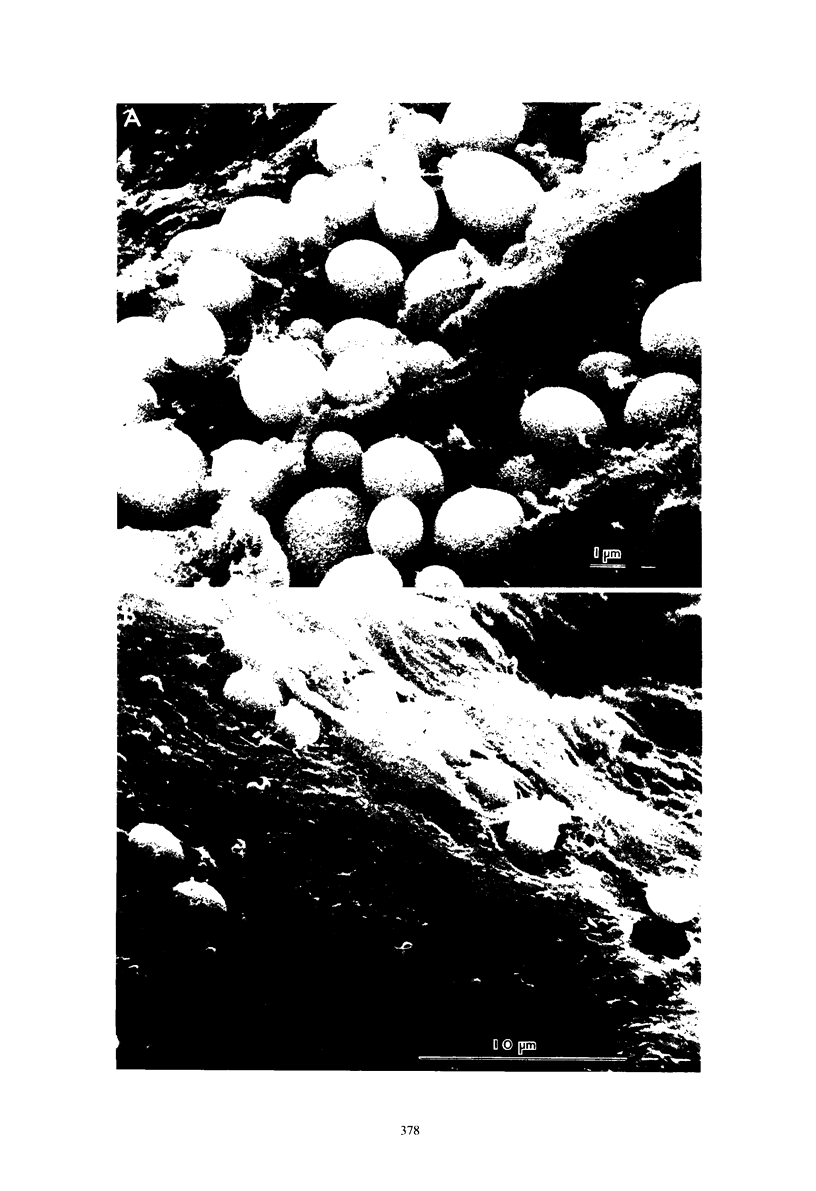

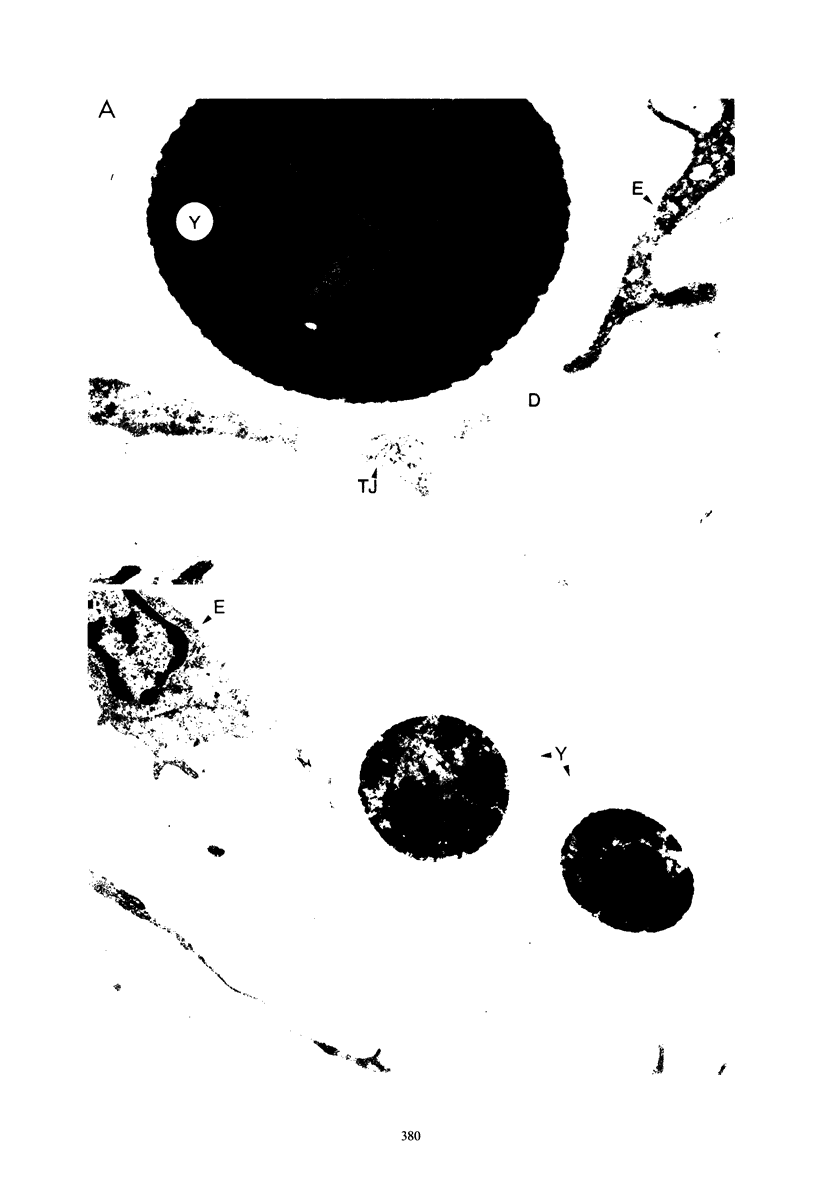
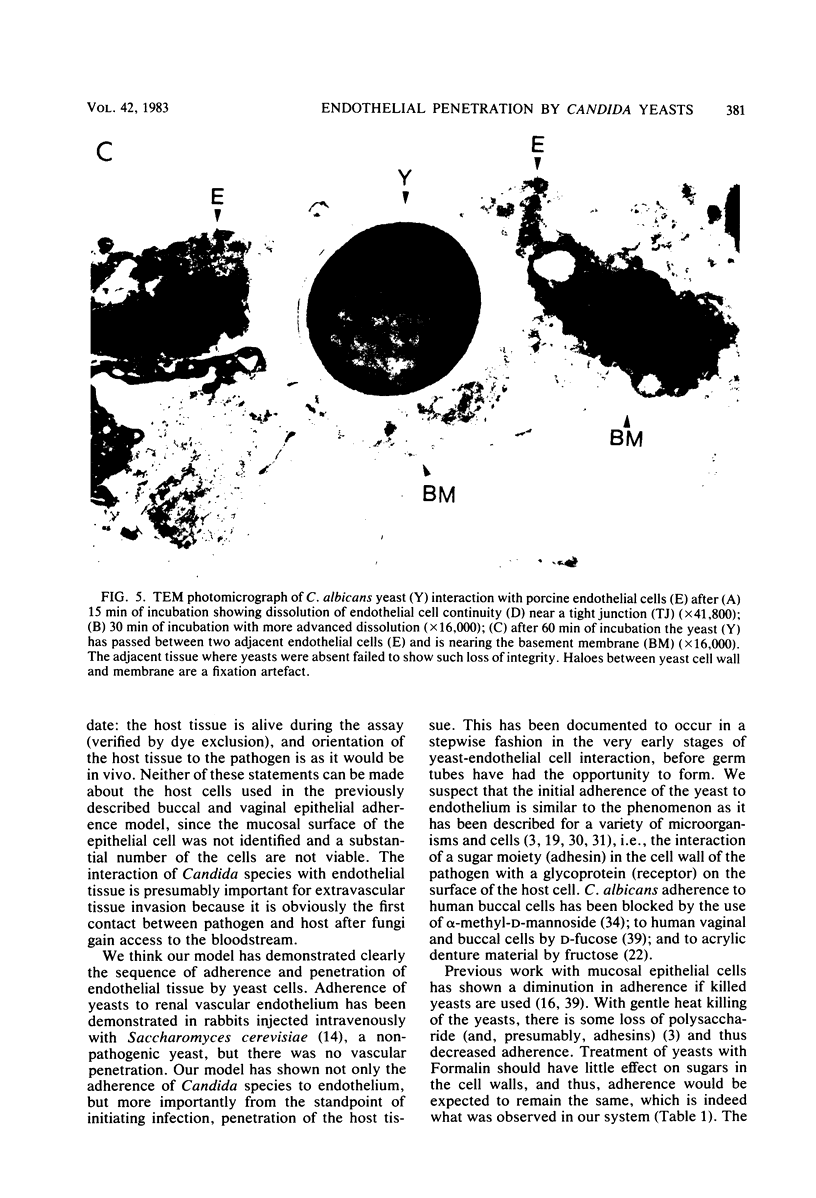
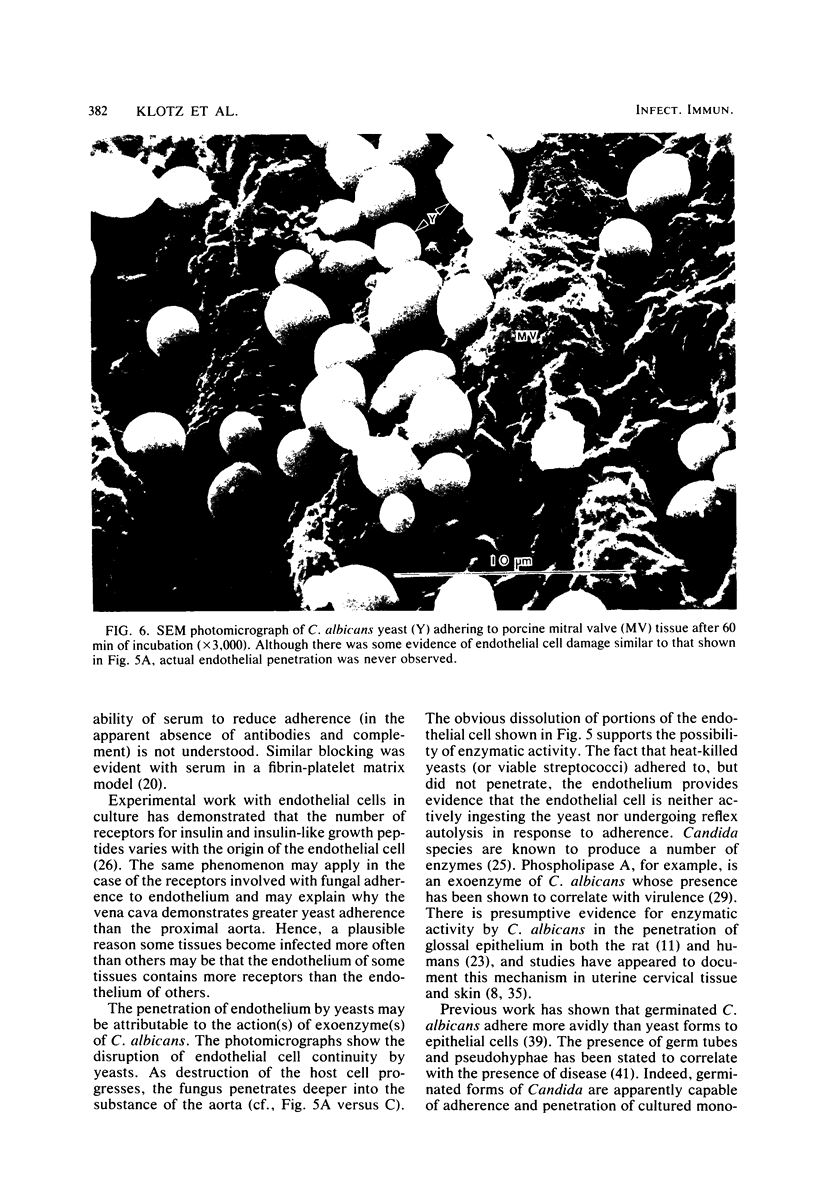
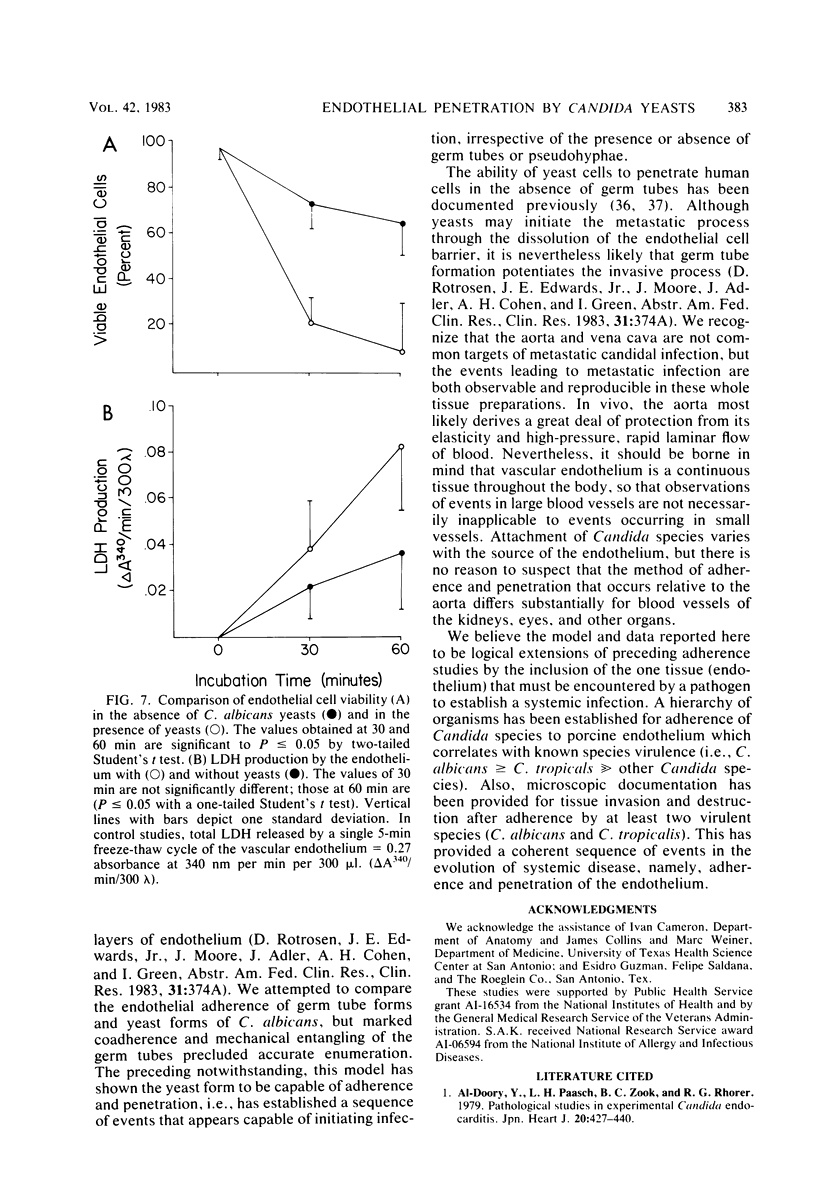

Images in this article
Selected References
These references are in PubMed. This may not be the complete list of references from this article.
- Al-Doory Y., Paasch L. H., Zook B. C., Rhorer R. G. Pathological studies in experimental Candida endocarditis. Jpn Heart J. 1979 Jul;20(4):427–440. doi: 10.1536/ihj.20.427. [DOI] [PubMed] [Google Scholar]
- Calderone R. A., Rotondo M. F., Sande M. A. Candida albicans endocarditis: ultrastructural studies of vegetation formation. Infect Immun. 1978 Apr;20(1):279–289. doi: 10.1128/iai.20.1.279-289.1978. [DOI] [PMC free article] [PubMed] [Google Scholar]
- Cassone A., Mattia E., Boldrini L. Agglutination of blastospores of Candida albicans by concanavalin A and its relationship with the distribution of mannan polymers and the ultrastructure of the cell wall. J Gen Microbiol. 1978 Apr;105(2):263–273. doi: 10.1099/00221287-105-2-263. [DOI] [PubMed] [Google Scholar]
- Edwards J. E., Jr, Montgomerie J. Z., Foos R. Y., Shaw V. K., Guze L. B. Experimental hematogenous endophthalmitis caused by Candida albicans. J Infect Dis. 1975 Jun;131(6):649–657. doi: 10.1093/infdis/131.6.649. [DOI] [PubMed] [Google Scholar]
- Edwards J. E., Jr, Montgomerie J. Z., Ishida K., Morrison J. O., Guze L. B. Experimental hematogenous endophthalmitis due to Candida: species variation in ocular pathogenicity. J Infect Dis. 1977 Feb;135(2):294–297. doi: 10.1093/infdis/135.2.294. [DOI] [PubMed] [Google Scholar]
- Freedman L. R., Johnson M. L. Experimental endocarditis. IV. Tricuspid and aortic valve infection with Candida albicans in rabbits. Yale J Biol Med. 1972 Apr;45(2):163–175. [PMC free article] [PubMed] [Google Scholar]
- Fryer D. G., Birnbaum G., Luttrell C. N. Human endothelium in cell culture. J Atheroscler Res. 1966 Mar-Apr;6(2):151–163. doi: 10.1016/s0368-1319(66)80019-4. [DOI] [PubMed] [Google Scholar]
- García-Tamayo J., Castillo G., Martínez A. J. Human genital candidiasis: histochemistry, scanning and transmission electron microscopy. Acta Cytol. 1982 Jan-Feb;26(1):7–14. [PubMed] [Google Scholar]
- Goldsmith J. C., Kisker C. T. Thrombin - endothelial cell interactions: critical importance of endothelial cell vessel of origin. Thromb Res. 1982 Jan 1;25(1-2):131–136. doi: 10.1016/0049-3848(82)90222-5. [DOI] [PubMed] [Google Scholar]
- Hart P. D., Russell E., Jr, Remington J. S. The compromised host and infection. II. Deep fungal infection. J Infect Dis. 1969 Aug;120(2):169–191. doi: 10.1093/infdis/120.2.169. [DOI] [PubMed] [Google Scholar]
- Howlett J. A., Squier C. A. Candida albicans ultrastructure: colonization and invasion of oral epithelium. Infect Immun. 1980 Jul;29(1):252–260. doi: 10.1128/iai.29.1.252-260.1980. [DOI] [PMC free article] [PubMed] [Google Scholar]
- Jaffe E. A., Nachman R. L., Becker C. G., Minick C. R. Culture of human endothelial cells derived from umbilical veins. Identification by morphologic and immunologic criteria. J Clin Invest. 1973 Nov;52(11):2745–2756. doi: 10.1172/JCI107470. [DOI] [PMC free article] [PubMed] [Google Scholar]
- Johnson A. P., Taylor-Robinson D., McGee Z. A. Species specificity of attachment and damage to oviduct mucosa by Neisseria gonorrhoeae. Infect Immun. 1977 Dec;18(3):833–839. doi: 10.1128/iai.18.3.833-839.1977. [DOI] [PMC free article] [PubMed] [Google Scholar]
- Johnston W. H., Latta H. Acute hematogenous pyelonephritis induced in the rabbit with Saccharomyces cerevisiae. An electron microscopic study. Lab Invest. 1973 Nov;29(5):495–505. [PubMed] [Google Scholar]
- Kimura L. H., Pearsall N. N. Adherence of Candida albicans to human buccal epithelial cells. Infect Immun. 1978 Jul;21(1):64–68. doi: 10.1128/iai.21.1.64-68.1978. [DOI] [PMC free article] [PubMed] [Google Scholar]
- King R. D., Lee J. C., Morris A. L. Adherence of Candida albicans and other Candida species to mucosal epithelial cells. Infect Immun. 1980 Feb;27(2):667–674. doi: 10.1128/iai.27.2.667-674.1980. [DOI] [PMC free article] [PubMed] [Google Scholar]
- Lehrer R. I., Cline M. J. Leukocyte myeloperoxidase deficiency and disseminated candidiasis: the role of myeloperoxidase in resistance to Candida infection. J Clin Invest. 1969 Aug;48(8):1478–1488. doi: 10.1172/JCI106114. [DOI] [PMC free article] [PubMed] [Google Scholar]
- Levine M. M. Adhesion of enterotoxigenic Escherichia coli in humans and animals. Ciba Found Symp. 1981;80:142–160. doi: 10.1002/9780470720639.ch10. [DOI] [PubMed] [Google Scholar]
- Liljemark W. F., Gibbons R. J. Suppression of Candida albicans by human oral streptococci in gnotobiotic mice. Infect Immun. 1973 Nov;8(5):846–849. doi: 10.1128/iai.8.5.846-849.1973. [DOI] [PMC free article] [PubMed] [Google Scholar]
- Maisch P. A., Calderone R. A. Adherence of Candida albicans to a fibrin-platelet matrix formed in vitro. Infect Immun. 1980 Feb;27(2):650–656. doi: 10.1128/iai.27.2.650-656.1980. [DOI] [PMC free article] [PubMed] [Google Scholar]
- Maisch P. A., Calderone R. A. Role of surface mannan in the adherence of Candida albicans to fibrin-platelet clots formed in vitro. Infect Immun. 1981 Apr;32(1):92–97. doi: 10.1128/iai.32.1.92-97.1981. [DOI] [PMC free article] [PubMed] [Google Scholar]
- McCourtie J., Douglas L. J. Relationship between cell surface composition of Candida albicans and adherence to acrylic after growth on different carbon sources. Infect Immun. 1981 Jun;32(3):1234–1241. doi: 10.1128/iai.32.3.1234-1241.1981. [DOI] [PMC free article] [PubMed] [Google Scholar]
- Montes L. F., Wilborn W. H. Ultrastructural features of host-parasite relationship in oral candidiasis. J Bacteriol. 1968 Oct;96(4):1349–1356. doi: 10.1128/jb.96.4.1349-1356.1968. [DOI] [PMC free article] [PubMed] [Google Scholar]
- Peacock M. L., Bar R. S., Goldsmith J. Interactions of insulin with bovine endothelium. Metabolism. 1982 Jan;31(1):52–56. [PubMed] [Google Scholar]
- Pope L. M., Cole G. T. SEM studies of adherence of candida albicans to the gastrointestinal tract of infant mice. Scan Electron Microsc. 1981;(Pt 3):73–80. [PubMed] [Google Scholar]
- Price M. F., Wilkinson I. D., Gentry L. O. Plate method for detection of phospholipase activity in Candida albicans. Sabouraudia. 1982 Mar;20(1):7–14. doi: 10.1080/00362178285380031. [DOI] [PubMed] [Google Scholar]
- Ramirez-Ronda C. H. Adherence of glucan-positive and glucan-negative streptococcal strains to normal and damaged heart valves. J Clin Invest. 1978 Oct;62(4):805–814. doi: 10.1172/JCI109192. [DOI] [PMC free article] [PubMed] [Google Scholar]
- Rauvala H., Carter W. G., Hakomori S. I. Studies on cell adhesion and recognition. I. Extent and specificity of cell adhesion triggered by carbohydrate-reactive proteins (glycosidases and lectins) and by fibronectin. J Cell Biol. 1981 Jan;88(1):127–137. doi: 10.1083/jcb.88.1.127. [DOI] [PMC free article] [PubMed] [Google Scholar]
- Rutter J. M., Burrows M. R., Sellwood R., Gibbons R. A. A genetic basis for resistance to enteric disease caused by E. coli. Nature. 1975 Sep 11;257(5522):135–136. doi: 10.1038/257135a0. [DOI] [PubMed] [Google Scholar]
- Sande M. A., Bowman C. R., Calderone R. A. Experimental Candida albicans endocarditis: characterization of the disease and response to therapy. Infect Immun. 1977 Jul;17(1):140–147. doi: 10.1128/iai.17.1.140-147.1977. [DOI] [PMC free article] [PubMed] [Google Scholar]
- Sandin R. L., Rogers A. L., Patterson R. J., Beneke E. S. Evidence for mannose-mediated adherence of Candida albicans to human buccal cells in vitro. Infect Immun. 1982 Jan;35(1):79–85. doi: 10.1128/iai.35.1.79-85.1982. [DOI] [PMC free article] [PubMed] [Google Scholar]
- Scherwitz C. Ultrastructure of human cutaneous candidosis. J Invest Dermatol. 1982 Mar;78(3):200–205. doi: 10.1111/1523-1747.ep12506451. [DOI] [PubMed] [Google Scholar]
- Schnell J. D., Voigt W. H. Are yeasts in vaginal smears intracellular or extracellular? Acta Cytol. 1976 Jul-Aug;20(4):343–346. [PubMed] [Google Scholar]
- Schnell J. D., Voigt W. H. Das Verhalten von Sprosspilzen am nicht verhornenden Plattenepithel. Arch Gynakol. 1974;217(4):377–382. doi: 10.1007/BF00668025. [DOI] [PubMed] [Google Scholar]
- Slater D. N., Sloan J. M. The porcine endothelial cell in tissue culture. Atherosclerosis. 1975 Mar-Apr;21(2):259–272. doi: 10.1016/0021-9150(75)90085-4. [DOI] [PubMed] [Google Scholar]
- Sobel J. D., Myers P. G., Kaye D., Levison M. E. Adherence of Candida albicans to human vaginal and buccal epithelial cells. J Infect Dis. 1981 Jan;143(1):76–82. doi: 10.1093/infdis/143.1.76. [DOI] [PubMed] [Google Scholar]
- TASCHDJIAN C. L., KOZINN P. J. Laboratory and clinical studies on candidiasis in the newborn infant. J Pediatr. 1957 Apr;50(4):426–433. doi: 10.1016/s0022-3476(57)80252-2. [DOI] [PubMed] [Google Scholar]
- WROBLEWSKI F., LADUE J. S. Lactic dehydrogenase activity in blood. Proc Soc Exp Biol Med. 1955 Oct;90(1):210–213. doi: 10.3181/00379727-90-21985. [DOI] [PubMed] [Google Scholar]









